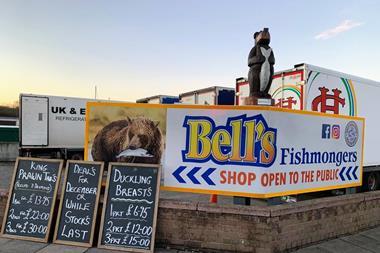>>How to keep a diverse high street - CLIFF GOODMAN, former trading director OF BUDGENS
Taking the decision to change career path has made me think of how the market has altered since I first started pedalling the butcher’s bicycle over the Marlborough Downs some 37 years ago, and to wonder what the future holds.
There can be no doubt that food retailing has changed dramatically. Village butchers, bakers, post offices and general stores are disappearing. Gone are such names as Victor Value, Keymarket, Gateway, Macfisheries, Fine Fare, International Stores and Bejam and more recently regional chains which served local communities - Jacksons and Bells, which were two of The Grocer’s Top 50 independents, Harts, Cullens, Europa - plus many small independents. There is now little diversity in the high street, with Tesco, Sainsbury, Asda and Morrisons controlling more than 75% of the nation’s grocery spend. While they have different strengths and weaknesses, they are broadly the same.
But I suppose this is progress, or is it? At the risk of sounding like one of those grumpy old men, I don’t believe consumers want all shops to be the same.
Yes, of course the multiples are good operators, some better than others, but are they better retailers than the businesses they are shutting down? In many cases, they are not, they just offer lower prices. Unless this changes we are heading for market domination and change can only come through legislation and co-operation.
The Competition Commission report to parliament in October 2000 stated that Budgens (then part of the £3bn buying group CBC), paid 11.1% more for branded grocery than Tesco and that “this difference was greater than could be explained by any operating differences”.
It also stated that below-cost selling, when conducted by Asda, Morrisons, Safeway and Tesco, “operated against the public interest”- it harmed smaller outlets. Furthermore, it stated that price flexing, when operated by Safeway, Sainsbury and Tesco, was against the public interest.
The Competition Commission also said it received many allegations from suppliers about the behaviour of the multiples and said there appeared to be a climate of apprehension among many suppliers. The outcome was the code of practice - and what a huge success that has been! Judging by the level of complaints to the DTI, you could be forgiven for thinking that the
multiples had transformed themselves. And turkeys would vote for Christmas.
Below-cost selling and price flexing continue and clearly we must continue the fight for legislation. Most shoppers put “good value for money” as the main reason for using a particular store and “convenient location” as the second [IGD research, August 2004]. Therefore, you would think a local store offering value for money would be the most successful retailing format. The problem, of course, is in “value for money”, which is difficult to deliver if your branded grocery is costing 11% more than Tesco’s.
The solution is co-operation between suppliers and wholesalers and retailers. Many suppliers operate closed price lists. Why can’t all suppliers issue price lists with the discounts for disciplines and supply chain efficiencies? Though costs to some might have to be reduced and to others, increased, it could put right past wrongs.
If the position continues, high streets and convenience stores will look the same and suppliers will have only one or two customers. Surely it would be better to level the playing field now while there is still a diversity of retail options. The way forward for a vibrant retail industry is a level playing field, from where retailers can compete, entrepreneurs can add flair to the high street and suppliers do not feel threatened by the muscle of the multiple.
Taking the decision to change career path has made me think of how the market has altered since I first started pedalling the butcher’s bicycle over the Marlborough Downs some 37 years ago, and to wonder what the future holds.
There can be no doubt that food retailing has changed dramatically. Village butchers, bakers, post offices and general stores are disappearing. Gone are such names as Victor Value, Keymarket, Gateway, Macfisheries, Fine Fare, International Stores and Bejam and more recently regional chains which served local communities - Jacksons and Bells, which were two of The Grocer’s Top 50 independents, Harts, Cullens, Europa - plus many small independents. There is now little diversity in the high street, with Tesco, Sainsbury, Asda and Morrisons controlling more than 75% of the nation’s grocery spend. While they have different strengths and weaknesses, they are broadly the same.
But I suppose this is progress, or is it? At the risk of sounding like one of those grumpy old men, I don’t believe consumers want all shops to be the same.
Yes, of course the multiples are good operators, some better than others, but are they better retailers than the businesses they are shutting down? In many cases, they are not, they just offer lower prices. Unless this changes we are heading for market domination and change can only come through legislation and co-operation.
The Competition Commission report to parliament in October 2000 stated that Budgens (then part of the £3bn buying group CBC), paid 11.1% more for branded grocery than Tesco and that “this difference was greater than could be explained by any operating differences”.
It also stated that below-cost selling, when conducted by Asda, Morrisons, Safeway and Tesco, “operated against the public interest”- it harmed smaller outlets. Furthermore, it stated that price flexing, when operated by Safeway, Sainsbury and Tesco, was against the public interest.
The Competition Commission also said it received many allegations from suppliers about the behaviour of the multiples and said there appeared to be a climate of apprehension among many suppliers. The outcome was the code of practice - and what a huge success that has been! Judging by the level of complaints to the DTI, you could be forgiven for thinking that the
multiples had transformed themselves. And turkeys would vote for Christmas.
Below-cost selling and price flexing continue and clearly we must continue the fight for legislation. Most shoppers put “good value for money” as the main reason for using a particular store and “convenient location” as the second [IGD research, August 2004]. Therefore, you would think a local store offering value for money would be the most successful retailing format. The problem, of course, is in “value for money”, which is difficult to deliver if your branded grocery is costing 11% more than Tesco’s.
The solution is co-operation between suppliers and wholesalers and retailers. Many suppliers operate closed price lists. Why can’t all suppliers issue price lists with the discounts for disciplines and supply chain efficiencies? Though costs to some might have to be reduced and to others, increased, it could put right past wrongs.
If the position continues, high streets and convenience stores will look the same and suppliers will have only one or two customers. Surely it would be better to level the playing field now while there is still a diversity of retail options. The way forward for a vibrant retail industry is a level playing field, from where retailers can compete, entrepreneurs can add flair to the high street and suppliers do not feel threatened by the muscle of the multiple.














No comments yet